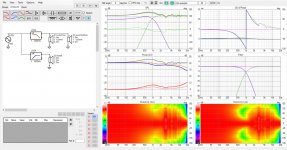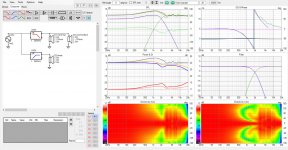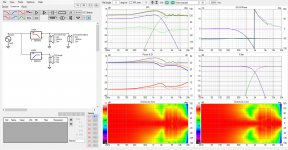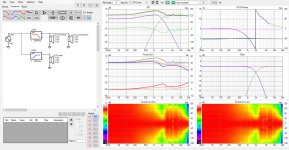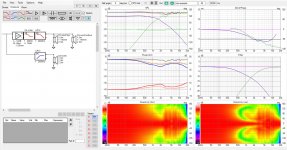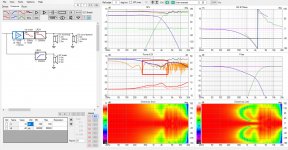Hi.
We had some amazing black Friday deals here and I ended up buying some speaker drivers for the fun of it.
I bought 4x TANGBAND W6-658A mid-woofers and 2x TANGBAND 25-302S tweeters.
I know it's not a perfect match, but the woofers were 13€ each and tweeters were 7€ each.
I saw that the woofers really didn't seem to have any severe cone brake up, and played flat up to 10k, almost not needing tweeters.
The tweeters looks like it could be crossed over at 3k rather well, but I was wondering about distance between drivers.
Then I thought about an MTM design. Does the MTM design make it so I can raise the crossover point because the mids' center point is in between, on the tweeter? Because if I could raise it, I could just do like a 6-10kHz crossover point with 1st order crossovers.
If not, I'll be using an 8.2uF cap to protect the tweeter and just use my PC as a DSP with active crossovers to my 100w/ch receiver with multi channel inputs. (I own a diy speaker tester and umik-1, so I might make passive crossovers later if I want to invest)
I also read that wiring the woofers in parallel increases the sensitivity with 6dB? So then they would be rather perfectly matched with the tweeters sensitivity, although baffle step might still F that up.
Then box size. I haven't really made my mind on floor standers or bookshelf speakers yet. I need new speakers for my desk, designed to fit with my new triple 32" screens, but then I "only" have a pair of B&W dm602s3 as fronts in my home theater.
I'm leaning towards floor standers because these woofers seem to have good specs to play down to 40-50hz easily.
If I do a floor stander, the next question is, what kind? Ported, t-line or rear loaded horn?
The woofers say they are made for bass reflex, but I modeled them in hornresp and they seem to work somewhat well in a 52l t-line. I have never heard a t-line and might want to try that, because while I want high sensitivity from these speakers, SQ is the priority.
I have a cinema f-20 sub to pair up with these, so I know what a horn sounds like, and I love the tight punch, but IDK what would be better.
I would love to hear your opinions and please teach me more about design and theory about this stuff.
We had some amazing black Friday deals here and I ended up buying some speaker drivers for the fun of it.
I bought 4x TANGBAND W6-658A mid-woofers and 2x TANGBAND 25-302S tweeters.
I know it's not a perfect match, but the woofers were 13€ each and tweeters were 7€ each.
I saw that the woofers really didn't seem to have any severe cone brake up, and played flat up to 10k, almost not needing tweeters.
The tweeters looks like it could be crossed over at 3k rather well, but I was wondering about distance between drivers.
Then I thought about an MTM design. Does the MTM design make it so I can raise the crossover point because the mids' center point is in between, on the tweeter? Because if I could raise it, I could just do like a 6-10kHz crossover point with 1st order crossovers.
If not, I'll be using an 8.2uF cap to protect the tweeter and just use my PC as a DSP with active crossovers to my 100w/ch receiver with multi channel inputs. (I own a diy speaker tester and umik-1, so I might make passive crossovers later if I want to invest)
I also read that wiring the woofers in parallel increases the sensitivity with 6dB? So then they would be rather perfectly matched with the tweeters sensitivity, although baffle step might still F that up.
Then box size. I haven't really made my mind on floor standers or bookshelf speakers yet. I need new speakers for my desk, designed to fit with my new triple 32" screens, but then I "only" have a pair of B&W dm602s3 as fronts in my home theater.
I'm leaning towards floor standers because these woofers seem to have good specs to play down to 40-50hz easily.
If I do a floor stander, the next question is, what kind? Ported, t-line or rear loaded horn?
The woofers say they are made for bass reflex, but I modeled them in hornresp and they seem to work somewhat well in a 52l t-line. I have never heard a t-line and might want to try that, because while I want high sensitivity from these speakers, SQ is the priority.
I have a cinema f-20 sub to pair up with these, so I know what a horn sounds like, and I love the tight punch, but IDK what would be better.
I would love to hear your opinions and please teach me more about design and theory about this stuff.
typically an mtm means you need to lower the crossover point because of the distance between the mids. For that combo of drivers you're gonna want to crossover as low as the tweeter can handle, I'm guessing 2500hz or so. I would prefer to cross at 1500-1880hz but I don't think that tweeter can do that.
Why is this? Because the mids are far from each other?
The tweeter is only 54mm wide, so the distance will be minimal compare to others.
How would I calculate how close to each other everything should be at which crossover point?
The tweeter is only 54mm wide, so the distance will be minimal compare to others.
How would I calculate how close to each other everything should be at which crossover point?
You measure the center to center distance of the two mids and try to crossover at 1/2 the wavelength that corresponds to that distance.
And If it really is a problem, should I do a 2.5-way instead or invest in a pair of like SB29RDNC-C000-4 or TANGBAND 28-847S instead that can be crossed over at 1.2kHz?
Okay so one woofers width and the tweeters height = 230.5mm
Then half of that? =115mm, which corresponds to 2982.61Hz
Which equals to the perfect crossover point for the tweeters?
Then half of that? =115mm, which corresponds to 2982.61Hz
Which equals to the perfect crossover point for the tweeters?
Couldn't vote due to driver specs being suitable for all your choices plus others, i.e. a 'jack o' trades, master of none' sort of driver.
Okay so one woofers width and the tweeters height = 230.5mm
Then half of that? =115mm, which corresponds to 2982.61Hz
Which equals to the perfect crossover point for the tweeters?
Hmm, according to the specs it's a 17.65 cm diameter face plate, so jammed together for the 1 WL max = ~34400/17.65 = 1949 Hz, too low for the offset tweeter's 1400 Hz Fs unless at least a 4th order XO is used.
Your way is fine for a woofer/tweeter, but not for an MTM unless [the lower] one is rolled off at ideally a 1/4 WL = ~34400/4/23 = ~323 Hz, so anywhere around this point that's best for baffle step compensation [BSC].
Okay so I understood the calculations wrong?
I know the driver isn't special for anything, but it was cheap and I can build enclosures.
So If I get any tweeter that can cross over at 1900 or less, I'm good for MTM?
How much and where does baffle step usually add? is it about 5-6dB so that one woofer crossed over low could smoothen that right out?
I could also go crazy and buy both new tweters for mtm and woofers for baffle step compensation.
Of course I would measure everything when I get them, just want to know somewhat well beforehand.
I know the driver isn't special for anything, but it was cheap and I can build enclosures.
So If I get any tweeter that can cross over at 1900 or less, I'm good for MTM?
How much and where does baffle step usually add? is it about 5-6dB so that one woofer crossed over low could smoothen that right out?
I could also go crazy and buy both new tweters for mtm and woofers for baffle step compensation.
Of course I would measure everything when I get them, just want to know somewhat well beforehand.
Okay so one woofers width and the tweeters height = 230.5mm
Then half of that? =115mm, which corresponds to 2982.61Hz
Which equals to the perfect crossover point for the tweeters?
230.5mm needs to be half a wavelength, so one wavelength = 461mm or ~748Hz to achieve good coupling and minimal vertical narrowing of the pattern up to crossover.
Of course many commercial MTM's don't achieve this, so you may get away with a slightly higher crossover, but 3kHz is going to put you at ~2 wavelengths spacing which is probably too far.
If you want to have a look at how bad the lobing might be, Tolvan Data's XDir & Basta! software both simulate this, as would VituixCAD.
Last edited:
MTM also produces incorrect power response in the room (i.e. as a whole, some parts of the "music" is "gone". It is a conceptual flaw of MTM and has to do with above mentioned interference. But oboy does it *look* cool. I would go 2 1/2 way as you said if you need the low end capacity. MTM is only for SPL reasons, nothing else (or distorsion which is the other side of the SPL coin).
//
//
Okay so I understood the calculations wrong?
So If I get any tweeter that can cross over at 1900 or less, I'm good for MTM?
How much and where does baffle step usually add? is it about 5-6dB so that one woofer crossed over low could smoothen that right out?
Frankly, your description confused me a bit, so rather than checking your math and knowing at a glance the MTM woofer spacing would be too wide, just pointed out that you need to put the drivers touching with the tweeter beside them as close as practical and make the speakers mirror image with the tweeters positioned to the outside, toe'd in as required.
As for your math, if the 230.5 mm is the total width of one woofer + tweeter, then the tweeter is only 230.5-176.5 = 54 mm wide? [I couldn't find any dimensions in a quick search earlier].
If so, then the ctc spacing is 230.5 mm = 344000/230.5 = 1494.41 Hz/1WL vs my 1949 Hz/1 WL, the generally accepted max distance between the woofers and not knowing the tweeter's dimensions, no clue how close the woofer/tweeter frequency will be.
It would be best in that the XO can be less complicated unless done with DSP, though it will be larger, so may lower the woofer/tweeter 1WL frequency depending on how you orient the current one.
BSC articles and of course if the lower woofer is rolled off to handle it, then woofer spacing can be 'relaxed' considerably: General Speaker Related Articles
FYI ideal drivers in MTM configuration simmed on 18x42cm baffle.
Attachments:
1. ~24cm c-c, op drivers crammed as close as possible, xo 1kHz
2. xo 2kHz
3. xo 3kHz
4. reduced c-c with 2kHz crossover (not possible in reality with these drivers on a flat baffle)
5. all drivers coinsident ( not possible in reality ).
1" tweeter without waveguide crossed to a 6" driver makes peak in directivity index and dip in the power response no matter the configuration MT or MTM. Smaller woofers or waveguide for the tweeter would make things better.
I have failed to see why someone would want MTM configuration other than for looks? The vertical narrowing provided by MTM configuration is only for small bandwidth and as such I'm not sure how usable that is? Maybe if the narrowing is targeted just right, to right bandwidth, for given application.
For example did some c-c sim tests a while back including simulated floor and ceiling reflection. It looked like no matter where (in vertical height) the drivers of multiway speaker were simulated there was pretty much interference around 1kHz due to floor and ceiling reflections I couldn't get to cancel. Above ~3kHz ear shouldn't hear them and below ~700Hz carefull height positioning could get rid of most. Even though this is very theoretical and using simplified simulations it kind of indicates the 1kHz region would be most problematic if any regarding first vertical reflections and their interference to the listening spot. Here the narrowing could be usefull I think. This would work out 5-6" drivers and tweeter between capable of 1-2kHz crossover I think, to avoid the extra side lobes forming and have narrow dispersion to angles of ceiling and floor reflection.
Anyway, it is just that the sound has physical size as Wavelength and the transducers have physical size in relation to the wavelengths as well as some extra for the rim and what not. This makes it impossible to get the drivers close enough to combine nicely unless the transducers are way smaller than wavelengths or third dimension is utilized like in a Multiple Entry Horn, there is some chance to get the drivers close enough to each other. MEH hides the physical dimension of the transducers behind waveguide wall (center can be adjusted positioning the taps) and drivers (outputs) are a bit closer each other due to third dimension allowing the drivers also be positioned bit closer to each other than on two dimension flat baffle.
ps. tweeter response suffers on lots of diffraction interference. Maybe MTMs still sound good despite the graphs don't look that good? never heard one.
Attachments:
1. ~24cm c-c, op drivers crammed as close as possible, xo 1kHz
2. xo 2kHz
3. xo 3kHz
4. reduced c-c with 2kHz crossover (not possible in reality with these drivers on a flat baffle)
5. all drivers coinsident ( not possible in reality ).
1" tweeter without waveguide crossed to a 6" driver makes peak in directivity index and dip in the power response no matter the configuration MT or MTM. Smaller woofers or waveguide for the tweeter would make things better.
I have failed to see why someone would want MTM configuration other than for looks? The vertical narrowing provided by MTM configuration is only for small bandwidth and as such I'm not sure how usable that is? Maybe if the narrowing is targeted just right, to right bandwidth, for given application.
For example did some c-c sim tests a while back including simulated floor and ceiling reflection. It looked like no matter where (in vertical height) the drivers of multiway speaker were simulated there was pretty much interference around 1kHz due to floor and ceiling reflections I couldn't get to cancel. Above ~3kHz ear shouldn't hear them and below ~700Hz carefull height positioning could get rid of most. Even though this is very theoretical and using simplified simulations it kind of indicates the 1kHz region would be most problematic if any regarding first vertical reflections and their interference to the listening spot. Here the narrowing could be usefull I think. This would work out 5-6" drivers and tweeter between capable of 1-2kHz crossover I think, to avoid the extra side lobes forming and have narrow dispersion to angles of ceiling and floor reflection.
Anyway, it is just that the sound has physical size as Wavelength and the transducers have physical size in relation to the wavelengths as well as some extra for the rim and what not. This makes it impossible to get the drivers close enough to combine nicely unless the transducers are way smaller than wavelengths or third dimension is utilized like in a Multiple Entry Horn, there is some chance to get the drivers close enough to each other. MEH hides the physical dimension of the transducers behind waveguide wall (center can be adjusted positioning the taps) and drivers (outputs) are a bit closer each other due to third dimension allowing the drivers also be positioned bit closer to each other than on two dimension flat baffle.
ps. tweeter response suffers on lots of diffraction interference. Maybe MTMs still sound good despite the graphs don't look that good? never heard one.
Attachments
Last edited:
One can trim the faceplate of a lot of tweeters and some mids
My center ( SB mids, DXT tweeter) is 11 inches c to c and I do cross @ 2500 as the DXT can do that. But I did not succeed yet in getting the phase correct without a notch. Yet. Good enough Anthem ARC can handle it, but not good enough.
Of course, the narrowing of the pattern is exactly what D'Apolitto suggests as a big advantage. I would not use those woofers above about 1500 personally. They are woofers, not mid-woofers, but really cheap, so have fun.
MTW, TLs were a clever idea when we did not understand proper TS design. Today a lot of work for no real gain. My opinion of course. I still prefer critical Q enclosures and don't try to push drivers out of their happy zone to keep excursion and distortion down. Not all woofers can do this within a reasonable box, so ported it often is.
My center ( SB mids, DXT tweeter) is 11 inches c to c and I do cross @ 2500 as the DXT can do that. But I did not succeed yet in getting the phase correct without a notch. Yet. Good enough Anthem ARC can handle it, but not good enough.
Of course, the narrowing of the pattern is exactly what D'Apolitto suggests as a big advantage. I would not use those woofers above about 1500 personally. They are woofers, not mid-woofers, but really cheap, so have fun.
MTW, TLs were a clever idea when we did not understand proper TS design. Today a lot of work for no real gain. My opinion of course. I still prefer critical Q enclosures and don't try to push drivers out of their happy zone to keep excursion and distortion down. Not all woofers can do this within a reasonable box, so ported it often is.
Since I still had the project open here is quick modification for previous example to your c-c and xo frequency. Added some baffle step compensation boost. Delay on the woofers is small and no much difference.
1. with LR4 filters
2. LR2
Yeah MTM smoothens out the floor and ceiling reflections. The orange line on the last two attachments is room response estimate with 240cm high ceiling, 90cm tweeter and listening height, 3m listening distance.
3. MT setup
4. MTM setup
Based on simulations I suspect if there is better sound in an MTM speaker it is due to this, reduced interference of floor/ceiling reflections around ~1kHz. If that is the case then this would be nice feature for any type of loudspeaker. At leas to my eyes the sims look like some other qualities like high frequency dispersion and power response smoothness is traded of for reduced floor and ceiling reflections where the ear is more sensitive... In which case there would be no point going for much smaller or larger mids, to get the reduced vertical dispersion here.
1. with LR4 filters
2. LR2
Yeah MTM smoothens out the floor and ceiling reflections. The orange line on the last two attachments is room response estimate with 240cm high ceiling, 90cm tweeter and listening height, 3m listening distance.
3. MT setup
4. MTM setup
Based on simulations I suspect if there is better sound in an MTM speaker it is due to this, reduced interference of floor/ceiling reflections around ~1kHz. If that is the case then this would be nice feature for any type of loudspeaker. At leas to my eyes the sims look like some other qualities like high frequency dispersion and power response smoothness is traded of for reduced floor and ceiling reflections where the ear is more sensitive... In which case there would be no point going for much smaller or larger mids, to get the reduced vertical dispersion here.
Attachments
Last edited:
... I mean go bigger or smaller c-c 😀 smaller mids could help horizontal dispersion, remove the narrowing there.
One more for the monolog. Popped up the c-c experiment mentioned earlier, modified it by little by adding another M above T. This is simulation of tall system with cardioid mid. It is originally WMT, 8" mid. In MTM setup c-c of the mids is 40cm with waveguide between.
It looks like that by luck the vertical dispersion gets narrower for the whole mid bandwidth for the current simulation of WMT. If i mute the waveguide tweeter massive lobes appear :O didn't investigate further. DI goes flat by luck, horizontal is a bit wider on the mid than on the tweeter and with MTM setup the roles change, if it matters at all. Anyway, nicer looking graphs with MTM is possible, although not sure if it sounds better. The orange in room estimate contains ceiling and floor reflections mentioned earlier, 3m etc. and their effect gets smaller with narrower vertical dispersion. Unfortunately the >1kHz region has still mucho effect on the ceiling and floor since the waveguide is not narrow enough. Make it narrower and everything else changes again.
Attached is a gif showing difference.
ps. sorry polluting your thread! Piqued my interest and motivated for few sims so for completeness sake I think thats all of it. Please continue 🙂
It looks like that by luck the vertical dispersion gets narrower for the whole mid bandwidth for the current simulation of WMT. If i mute the waveguide tweeter massive lobes appear :O didn't investigate further. DI goes flat by luck, horizontal is a bit wider on the mid than on the tweeter and with MTM setup the roles change, if it matters at all. Anyway, nicer looking graphs with MTM is possible, although not sure if it sounds better. The orange in room estimate contains ceiling and floor reflections mentioned earlier, 3m etc. and their effect gets smaller with narrower vertical dispersion. Unfortunately the >1kHz region has still mucho effect on the ceiling and floor since the waveguide is not narrow enough. Make it narrower and everything else changes again.
Attached is a gif showing difference.
ps. sorry polluting your thread! Piqued my interest and motivated for few sims so for completeness sake I think thats all of it. Please continue 🙂
Attachments
Last edited:
I have failed to see why someone would want MTM configuration other than for looks? The vertical narrowing provided by MTM configuration is only for small bandwidth and as such I'm not sure how usable that is? Maybe if the narrowing is targeted just right, to right bandwidth, for given application.
+ 1 WRT point source drivers, HIFI/HT apps in general, but many have successfully used it with compression horn/WGs + [mid] bass woofers combined with large baffles [by HIFI/HT forums standards] where high directivity control is required.
- Home
- Loudspeakers
- Multi-Way
- Help designing my MTM t-line, or something better with my drivers?
